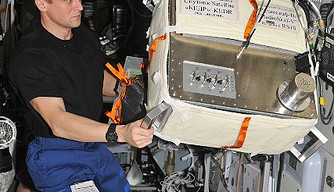ARISSat-1 Amateur Satellite built by Microchip engineers
on

A volunteer team of Microchip engineers spent nearly four years working on nights and weekends to develop the ARISSat-1 amateur satellite. On August 3 at 7:30 a.m. (Pacific Time) their hard work will come to fruition when the crew of the International Space Station (ISS) is scheduled to deploy the satellite during a spacewalk.
The deployment will be broadcast live on NASA TV and online. Additionally, ARISSat-1 design-team leader Steve Bible launched the limited-series Chips in Space Blog on EE Times’ Web site last week, to both educate and entertain readers by relating the story of how he and his colleagues came to build the satellite, and the challenges they ran into along the way. Bible will also provide analysis of the satellite’s deployment and functionality.
ARISSat-1 is the prototype test flight for a proposed series of educational satellites being developed in a partnership with the Radio Amateur Satellite Corp. (AMSAT), the NASA Office of Education ISS National Lab Project, the Amateur Radio on ISS (ARISS) working group and RSC-Energia.
If all goes well with the deployment of the new satellite, it will perform the following primary functions:
Two-way communication via UHF uplink and VHF downlink, for use by ham radio operators
Visuals of space from four cameras
Recharging of the satellite’s battery using solar panels, enabling operation for months
Transmission of audio greetings in many languages, for reception via simple radios or scanners
Telemetry transmissions with updates on the health of the satellite
House an experiment from
Russia’s Kursk University that measures atmospheric pressure


Discussion (0 comments)